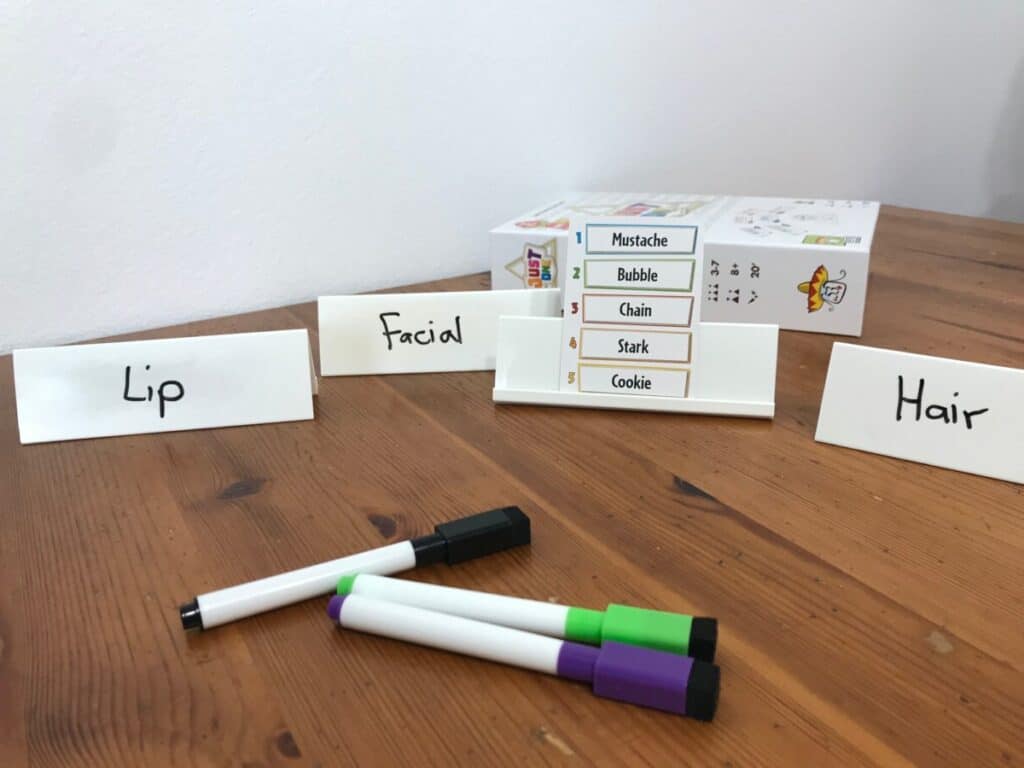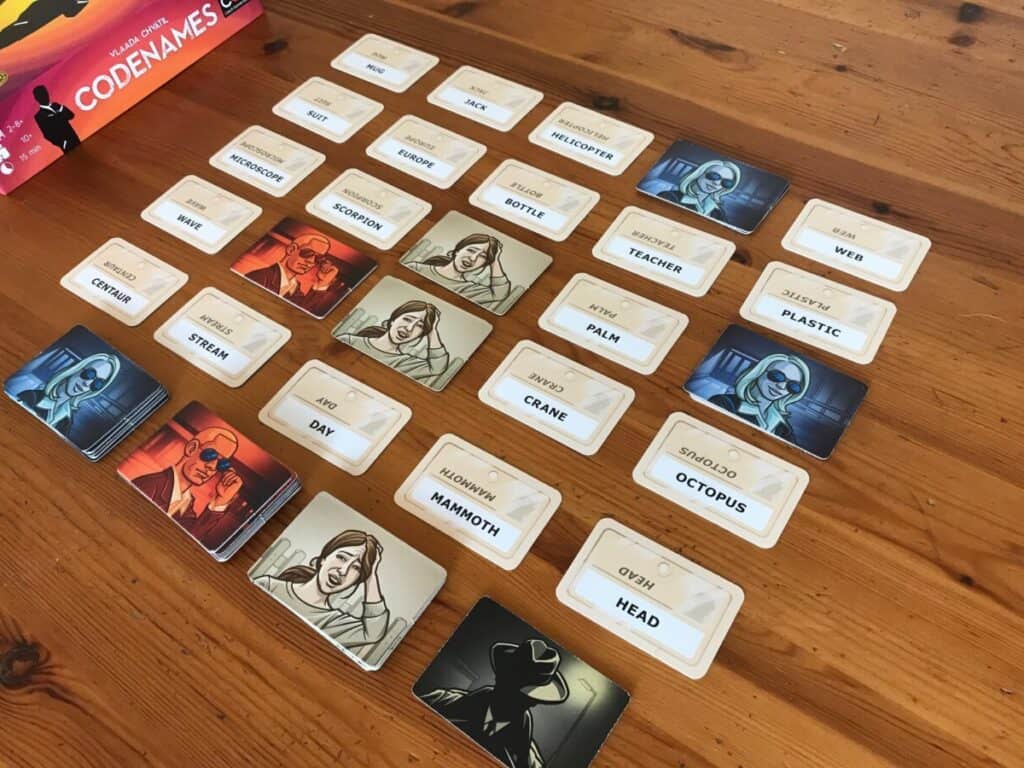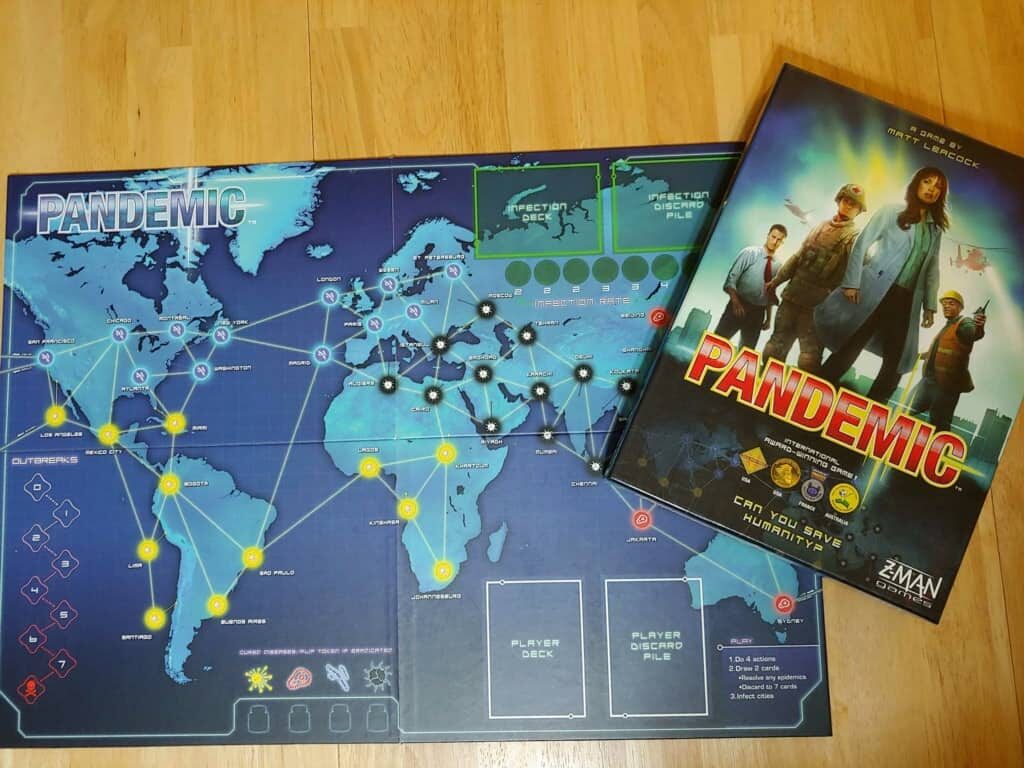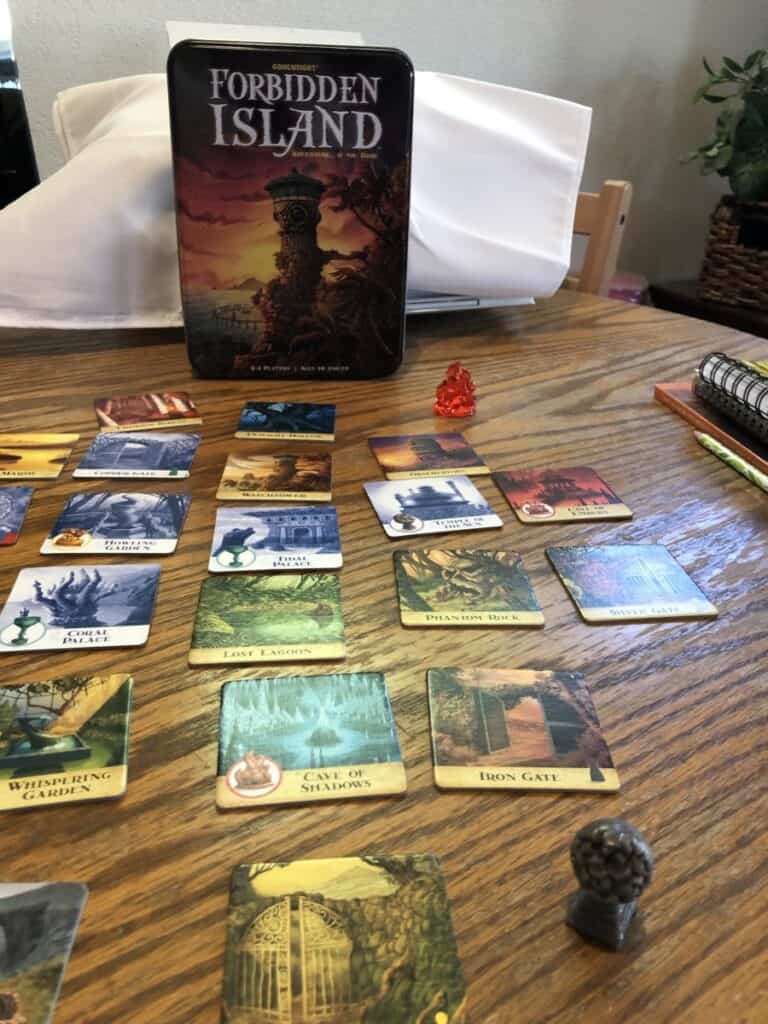Cooperative board games are unique in the board game world. Instead of fighting tooth and nail to be the number one finisher—winning the bragging rights—players all work together to win the game as one unit. If it doesn’t go well, everyone loses; but when the cards do fall the right way, everyone is happy.
I have to admit, this type of game is one of my least favorites. I find myself gravitating toward games that I compete against my friends and family while playing board games—instead of working with them. Obviously, like most things in life, there are some exceptions, which is where this list came from. Initially, I didn’t want to write this list for that very reason; however, I decided that since I don’t traditionally like these games, it would be useful to make a list of games that I actually do enjoy. It may be backwards logic, but I figure seeing a list of games that a person who doesn’t traditionally like to play, might be some of the best games of that category. So here we go…
What are 8 of the best cooperative board games?
- Hanabi
- Just One
- Spirit Island
- Codenames Duet
- Magic Maze
- Pandemic
- Forbidden Island
- Arkham Horror
Now that we’ve shown you our list, let’s get down to how they play and why they’re fun. Each of the games on this list are unique and fun in their own ways, which means that you may like one and not the other. For a full list of all of our (not just mine) favorite cooperative games, check out our resources page here.
1) Hanabi
Specifics
| Players | Duration | Age | Difficulty | Type | Price |
| 2-5 | 30 minutes | 8+ | Easy/medium | Card | $8 |
How Hanabi plays
Hanabi is a card game that has been around for several years now. In Hanabi players are working together to complete various colored piles of cards in the middle. The catch is that each player cannot see the cards in his own hand—but everyone else can see them. Players take turns giving clues to other players to notify them of which cards they hold without actually saying it directly. When a player is confident in a card she holds, she can either play it or discard it. The game ends when 3 tries fail, all moves are completed or clues run out. The players total their points and see how they did.
Why Hanabi is fun
Hanabi is an awesome game because it reverses the normal card game style. Instead of players knowing which cards they own—and hiding them from other players—only the other players know. The player holding the cards is unaware of the values of those cards. This creates an interesting dynamic that forces players to work together and get creative. Players need to give clues, trust the clues of others and cross their fingers that they won’t regret the choices they make.
The other fun thing about Hanabi is the constrained nature of clues and guesses. Players can give as many clues as they want—as long as they have tokens to use. If they run out of tokens, they can’t give any more clues. This causes the team to not only give clues to alert players of cards to play, but also of cards to discard to earn more clue tokens. Players must balance this or the game can get out of hand very quickly.
2) Just One

Specifics
| Players | Duration | Age | Difficulty | Type | Price |
| 3-7 | 20-30 minutes | 8+ | Very Easy | Party, Word | $22-$25 |
How Just One Plays
Just One is a fairly new word party game, released in 2018. In Just One, players work together to get the highest score possible. Each player takes a turn choosing a card with various words on it—without looking at it. She chooses a number 1-5, each of which has an associated word. Once chosen, players think of a one-word clue that somehow reveals the mystery word. The trick is that players can’t expressly say the word. Once all clues are written, players compare the clues. Any duplicates are eliminated—the rest are shown to the player. She must then figure out the secret word only by the clues written by the other players.
Why Just One is fun
Just One is fun for a few reasons. The first of which is that it’s a thinking game. That may scare off a few, but don’t worry, it’s not a complicated thinking game. In fact, it’s one of the easiest games on this list. Players use one-word clues to help another player guess the right word. So that naturally requires players to rack their brains for the best, most useful clues they can. The better they get at this, the easier guessing will be for the player in the hot seat.
Another thing that makes Just One so great is that the length of the game can be easily adapted to the group. Technically the game is played over 13 rounds—but it doesn’t matter one bit if you change it to 5 rounds or 20 rounds. When we play, we usually keep playing until everyone has to leave or the group wants to move on to another game. We never track how many rounds have been played or how the group performed when compared to the number in the rule book.
3) Spirit Island
Specifics
| Players | Duration | Age | Difficulty | Type | Price |
| 1-4 | 90-120 minutes | 13+ | Hard | Fantasy, Mythology | $50 |
How Spirit Island plays
In Spirit Island, players are working together to spread each spirit’s presence throughout the land to protect it from the evil invaders. The Invaders are attempting to explore the land and remove any presence from the spirits. If they accomplish this, the team loses; however, the team wins when it destroys all of the exploring invaders, as well as their cities and towns. Complexity in the game can vary depending on the level of interest of the players, but players use their individual spirits to take control of the game and destroy the invaders.
Why Spirit Island is fun
I will be the first to admit that this game is harder than most of the others on this list. So it’s probably not the one to get if you’re not into games that are more complicated. For the rest of you, this is an awesome cooperative game that has a lot going on. In other words, the complexity and adaptability of Spirit Island is what makes it so great. The characters and randomness built into the game create enough change that the game is a challenge each time it’s played—a different challenge each time it’s played.
4) Codenames Duet

Specifics
| Players | Duration | Age | Difficulty | Type | Price |
| 2-4 | 15-30 minutes | 11+ | Easy/medium | Word | $20 |
How Codenames Duet plays
Codenames Duet is a slightly altered version of the very popular game, Codenames. In Codenames Duet, players work together from a set of 25 cards on the table between them. Each card has a random word on it. Nine words are assigned to one player and nine are assigned to the other (three words are the same). Players take turns giving clues to each other that identify one or more of their assigned words. They must be careful though. Some of the words on the grid are “assassin” cards. If a player erroneously chooses one of these cards—thinking it’s one of the assigned words—the team automatically loses. If, instead, the players find all words, they win the game.
Why Codenames Duet is fun
Codenames Duet is fun specifically because it’s similar to the original Codenames, but it’s been altered for two players. So many fun games are great if you have 3-5+ players; but as soon as you try to play with only two, the game plays differently—usually not as fun. Codenames Duet, though a completely different game you must buy, is very similar to Codenames in how the game plays. Players take turns giving clues to each other to “solve the puzzle”.
The other great thing about Codenames Duet is that it’s built to be a campaign for the players. Generally, since it’s targeted at two-person groups, it’s often meant to be played by couples that like to play games together as their fun at the end of the day. Obviously, there are many other possibilities for this game, but this is what it’s meant for. Consequently, the game is built so that the players must play the game, not just to win, but to complete specific challenges. The game comes with a map and specified locations. Players start at whatever location they desire and move to another location when they have completed the current one. Each location requires that the group completes the game in a different way than they did previously. This creates a challenge and incentive for players to keep playing and learn new strategies.
5) Magic Maze
Specifics
| Players | Duration | Age | Difficulty | Type | Price |
| 1-8 | 15-20 minutes | 8+ | Easy | Mystical | $30 |
How Magic Maze plays
Magic maze is a bit different than the other games we’ve included on this list. Unlike the others, it is a real-time game; which means that all players are playing their turns simultaneously. The entire goal of the game is for the team to enter a shopping center, steal a set of items and make it out before the timer runs out. Each player is assigned a task that only they can do. For example, a player may be assigned as the only player that can move forward, while another player is assigned the ability to move backward. Magic Maze also comes with several levels that the players advance toward as they complete one. So there is always a greater challenge to take on.
Why Magic Maze is fun
What makes Magic Maze a fun game is it’s cooperative and real-time nature. Players taking turns at the same time is a common game mechanic used in competitive games—but the players are usually competing against one another. Magic Maze takes a different approach. Players are working together while taking their turns together. The game just feels different; it tends to get exciting as players work with each other to beat the clock.
Another great thing about Magic Maze is that it is a fairly short strategic game. The total time commitment is somewhere around 10-20 minutes. Yet the game doesn’t sacrifice strategy and depth to accomplish it. It’s still challenging and it still requires players to think and coordinate with one another. But it does all of that in a compact time frame. It’s perfect for groups that like strategic games, but don’t want to be sitting around the table for hours at a time.
6) Pandemic

Specifics
| Players | Duration | Age | Difficulty | Type | Price |
| 2-4 | 45 minutes | 8+ | Medium | Cooperative | $30 |
How Pandemic plays
Pandemic is one of the most iconic cooperative games in history. In Pandemic, the team is fighting to save the world from a number of diseases that threaten to kill everyone in it. Players take turns traveling the globe to find, research and eradicate the diseases that are in play. Throughout the game players draw cards that have the potential to initiate epidemics in various locations around the world. If they aren’t careful, epidemics can cause a chain reaction that can create problems for many cities at the same time. Each player has special abilities, though, that will help the team fight the diseases. The goal is to cure all four diseases that are in play during a given game; so once this is done, the team wins.
Why Pandemic is fun
Because of the way that Pandemic is structured, there are many paths the game can take. Once a team has successfully finished the game, they can start another immediately and it can look and feel completely different. In other words, it’s a challenge no matter how many times you’ve played. This is perfect for people that like to play the same game over and over again.You still get the overall feel of Pandemic, but the specifics change each time. Just because you won once, doesn’t mean you’ll win again the next time.
It doesn’t take new players long to realize what else makes Pandemic so great. Like so many other great games, Pandemic makes you really think and plan out how to win. You are playing with limited turns and limited resources, and the clock is ticking. If you don’t think it through, the game will be lost before you even know what happened. So for those that love a challenge, this is just the right game for you.
The last thing I really enjoy about Pandemic is a bit more technical. The way that Pandemic is designed, with respect to how the diseases spread, is genius. The maximum number of disease cubes that can be placed on a city is three. Whenever there is a situation where a fourth disease cube would be placed on a city an outbreak occurs; every city connected to that city receives a disease cube. If any of those cities already has three, a chain reaction occurs. This is so great because it makes this game more challenging and increasingly difficult. Again for those that like a challenge, look no further. That seems to be the theme of our analysis of Pandemic!
7) Forbidden Island

Specifics
| Players | Duration | Age | Difficulty | Type | Price |
| 2-4 | 30 minutes | 10+ | Easy | Cooperative | $15 |
How Forbidden Island plays
Forbidden Island is a game with one awesome theme! In this game, players are working together to recover four treasures before the island they are on sinks. Each player has an ability that will help as specific areas on the island start to sink. During play, the group attempts to keep the island afloat, collecting treasure cards and moving toward treasure tiles. If the team manages to get all four of the valuable items, they still must find a way to get back to the helicopter pad and get off the island. If they do this, they win. Like Pandemic, it has various levels of difficulty. So depending on how much of a challenge players want to take on the game can be adjusted to them.
Why Forbidden Island is fun
One thing that makes Forbidden Island great is the sense of urgency that players feel throughout the game. The island is sinking and you don’t want to be stuck on it when it goes down. As cards are turned over and areas start to sink, players start to “panic” and start to get serious about getting off the island. Even when players aren’t really into the game, they find themselves looking for every possible way to make it happen.
Another point that should be mentioned about why Forbidden Island is a great game is its simplicity. After taking a few minutes to learn the basics of the game, there isn’t much more to learn. Unlike some other games on this list, most of this game can be learned as it’s played. Half of my family doesn’t like to play games at all and we can get them to play this one because it’s simple. It’s the perfect, simple cooperative game to get out when you are still looking for a challenge.
8) Arkham Horror
Specifics
| Players | Duration | Age | Difficulty | Type | Price |
| 180 | 180 minutes | 14+ | Hard | Cooperative | $45 |
How Arkham Horror plays
Arkham Horror is another game with an awesome theme. In Arkham horror the players are a team of investigators that are trying to save the world from an invasion. During the game, each player takes turns trying to close the portals that appear before the aliens can make their way through to our world. Worse yet, these aliens are only the beginning. The Ancient One (a stronger, more difficult to kill opponent) is coming too. If the team manages to close the portals and defeat the aliens, they win. If not, the world suffers.
Why Arkham Horror is fun
Admittedly, Arkham Horror isn’t the easiest game to play that’s on this list. But it is fun. What I like about it is how the theme and the actual game mechanics (the physical things players do to play the game) work so well together. There is a lot going on, and the game can take many different routes to reach a conclusion.
Though I’m not usually a huge fan of board games that last longer than an hour, I definitely still enjoy Arkham Horror. There’s something about it that keeps you entertained and makes you want to keep playing. If you’re looking for a cooperative game that has an awesome theme and fun gameplay, this is a great choice!
Conclusion
So there you have it. These are 8 cooperative board games that we enjoy playing on an ongoing basis. As mentioned previously, you can find a full list of our favorite board games by clicking here.
